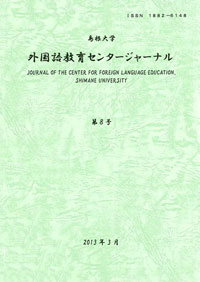島根大学外国語教育センター
ISSN:1882-6148

ダウンロード数 : ? 件
この文献の参照には次のURLをご利用ください : https://ir.lib.shimane-u.ac.jp/6483
島根大学外国語教育センタージャーナル 2
2007-03 発行
L1韓国語話者のL2日本語習得に見られる中間言語音声体系の特徴
金 菊煕
ファイル
内容記述(抄録等)
It has been suggested that effective speech learning is possible only until a critical
period that ends near the beginning of adolescence and very few individuals who start
to learn a second language in adulthood manage to speak it without a detectable
foreign accent. Foreign-accented speech is understood by Munro(1998) as
non-pathological speech that differs in some noticeable respects from native speakers’
pronunciation norms.
This article has reviewed the result and questions which were found by the
previous study of Kim(1999). It was originally intended to assess the general relation
between adult Korean subjects’ total years of learning Japanese and the overall
degree of a perceived foreign accent in their production of Japanese sentences. It also
aimed at investigating how native and non-native speakers differ in their perception
of foreign accents of other Korean speakers’ L2 Japanese. The experimental group
consisted of adult Korean-born learners who began to learn Japanese as a second
language after their puberty.
period that ends near the beginning of adolescence and very few individuals who start
to learn a second language in adulthood manage to speak it without a detectable
foreign accent. Foreign-accented speech is understood by Munro(1998) as
non-pathological speech that differs in some noticeable respects from native speakers’
pronunciation norms.
This article has reviewed the result and questions which were found by the
previous study of Kim(1999). It was originally intended to assess the general relation
between adult Korean subjects’ total years of learning Japanese and the overall
degree of a perceived foreign accent in their production of Japanese sentences. It also
aimed at investigating how native and non-native speakers differ in their perception
of foreign accents of other Korean speakers’ L2 Japanese. The experimental group
consisted of adult Korean-born learners who began to learn Japanese as a second
language after their puberty.
About This Article
Other Article
